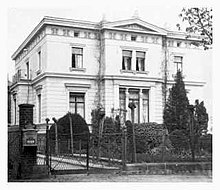Villa Koecher
The Villa Koecher is a historicist villa with a garden in the city of Halberstadt in Saxony-Anhalt . It was created together with an ensemble of other representative buildings outside the historic city wall on Magdeburger Strasse (now Hindenburgstrasse).
Development and construction history
The Villa Koecher was built for Erich Köcher and completed in 1879, as can be seen from the construction documents in the Halberstadt city archive . In 1945, along with large parts of Halberstadt, the immediate vicinity of Villa Koecher also fell victim to the flames during the bombardment of April 8, whereby the villa itself, but not the associated coach house, was spared from a direct bomb hit. Between 1945 and 1990 more and more damage occurred that was only poorly repaired or not repaired at all because building material could not or was not allowed to be procured. The renovation is being carried out carefully, with the preservation of the historical substance being a top priority.
Use of Villa Koecher
Before the turn of the 20th century, Villa Koecher housed the practice of the homeopath Niedieck. The building owner, Erich Köcher, sold the building around 1900 to the married couple Auguste and Johannes Maak, pharmacy owners in Halberstadt. Johannes Maak took part in the excavations and the scientific recording of the Halberstadt dinosaur finds. From 1928 onwards, Villa Koecher housed the dental practice of Dr. Wilhelm Maak. His sister, Elisabeth Maak, worked as a piano teacher in the house.
During and after the Second World War, bombed out people and refugees found temporary refuge.
After 1950, parts of the building were the NDPD assigned (National Democratic Party) who, during the turn of the Liberal Democratic Party to the Alliance of Free Democrats merged, eventually the FDP joined. Villa Koecher used this until around 1993.
Another part of the building housed the Urania from 1971 until immediately after the fall of the Wall .
A compulsory administration by the VEB building management existed until the end of the existence of the GDR .
Classification in art and architecture history
The architecture of Villa Koecher is in the style of Italian classicism . Also worth mentioning is the artistically designed cast iron railing of the stairwell.
As a very unusual feature for this time , the building has a flat roof with central drainage, which was originally made of soldered zinc sheet. Today, the roof is covered with polyester fleece for reasons of roofing security and provided with extensive green roofs for climatic and ecological reasons .
In addition, a collection of pianos and fortepiano from Elisabeth Maak's time is preserved in the rooms of the villa.
The garden
Worth mentioning is the front garden with a rarely large specimen of a box tree , probably part of the initial layout of the garden, as well as a hollow hawthorn consisting of several trunk pieces , a yew tree with a strong trunk that has been cut back again and again and a large, purple-blooming, non-root lilac . The front garden probably originally had the character of a representative ornamental garden with strictly shaped shrubs. In spring it is worth seeing because of the early bloomers that grow like a carpet.
The rear garden is - and always has been - a kitchen garden, which among other things has a remnant of the old fruit trees.
Entry as a memorial
The Villa Koecher was placed under monument protection as early as the 1970s by the monument authority of the Halberstadt district . Since the building is just outside the urban redevelopment area, no public funds have been made available to support the redevelopment of the building.
literature
- Dehio-Handbuch der Deutschen Kunstdenkmäler, Saxony-Anhalt I: Administrative region of Magdeburg. Deutscher Kunstverlag, Munich / Berlin 2002, p. #.
Individual evidence
- ↑ Fossil-bearing plistocene Holtemme gravel near Halberstadt in the northern Harz foreland. ( Memento of September 27, 2007 in the Internet Archive ) In: Journal of the German Society for Geosciences , Volume 1907, p. #.
- ↑ Paleontological considerations on the Harz region with explanations of Maak's Sauerier finds ( Memento from June 11, 2007 in the Internet Archive )
Coordinates: 51 ° 53 ′ 50 ″ N , 11 ° 3 ′ 39 ″ E
